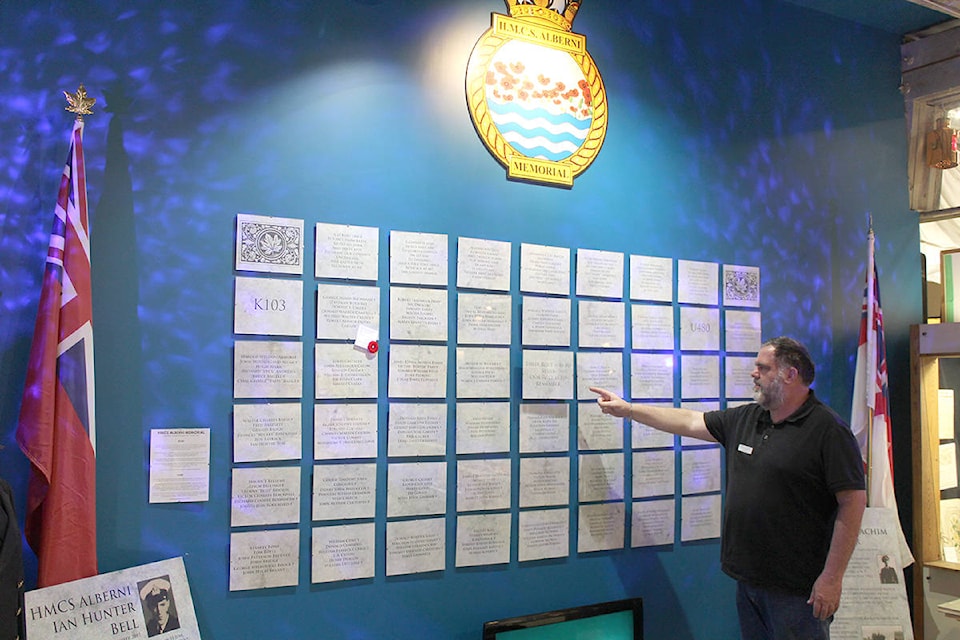By Dave Flawse
Special to The Record
Three simple words form the slogan of the HMCS Alberni Museum and Memorial (HAMM): I will remember. On June 6, HAMM invites you to remember the turning point of the Second World War at 5-625 Cliffe Ave. in the Courtenay Mall Mews for the 75th anniversary of D-Day.
To commemorate the day that Allied troops stormed the beaches of Normandy, volunteer and veteran Bob Sackett will be unveiling two large panels that outline Canadian involvement in the landings.
The first 100 visitors to the museum will receive a poster from Juno Beach Centre and everyone will get a packet of poppy seeds to plant in remembrance. The museum opens at 10 a.m.
HAMM isn’t a typical war or military museum. Its exhibits focus on the human element and the personal stories of everyone affected by war on both sides of conflicts.
Sackett reflects on a memorial that forms the heart of HAMM. It’s a list of names of not only those who served on the HMCS Alberni, but also the names of the men who served on U-480—the German submarine that torpedoed and sunk the Canadian Flower-Class Corvette.
When asked why a Canadian memorial would also commemorate men serving in the German Kreigsmarine in WWII, Sackett says it was the German government that instigated the war and that the men who sunk the HMCS Alberni on Aug. 21, 1944 “were just doing their job.”
After serving 31 years in the Royal Canadian Navy, Sackett retired in 2016. He began volunteering with HAMM after answering an ad to help them move furniture.
Almost three years later and he’s an integral part of the museum.
“I wish I could clone him,” says museum founder Lewis Bartholomew.
Before getting involved with HAMM, Sackett had never researched history. Now he researches many of the exhibits and created the two D-Day panels.
Sackett volunteers his time because he believes in the importance of remembering. He doesn’t want young people to forget what happened, so it doesn’t happen again.
“Sounds cliché,” he says. “But it’s exactly how I feel.”
Inspired by a painting of the HMCS Alberni on a B.C. ferry, Bartholomew created HAMM in 2002. Seventeen years later and the museum sees upwards of 4,000 visitors a year. The exhibits are mostly personal artifacts donated by family members or directly by those who served.
One such artifact is a recovered leaflet dropped by airplane behind enemy lines. It warns French citizens that the Allied army has just taken the beaches of Normandy, and to prepare themselves for the ensuing bombings and fighting.
Bartholomew and Sackett continue to tell the untold stories of war. One of last year’s exhibits, Innocent Eyes, came from their realization that children’s experiences in war are seldom told.
“Military museums really just focus on the adults,” says Bartholomew. “We very rarely talk about children.”
The museum’s slogan “I will remember” is embodied in the living field of poppies on their plaque. The poppies represent everyone involved with war. And as the older poppies fade and become reseeded, “It’s up to us,” says Bartholomew. “To remember going into the future.”
As part of that remembering, HAMM is creating a video reading of the poem Destruction Came Fast by Leo McVarish, a sailor on the HMCS Alberni at the time of its sinking.
Upcoming exhibits include A Sailor’s Sketch Book: Glimpses of War Through Art. It opens June 3 and continues throughout the summer.
The museum accepts donations and is always looking for volunteers for various jobs, including manning the front desk, cataloguing artifacts and updating the library.
